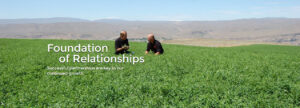Alfalfa hay harvest is now in full swing.But how does the producer know when to cut their alfalfa to yield the best quality hay? A producer with years of experience under their belt can probably take a look at his field and determine if it is ready to cut. A practical method that requires just a few measurements was developed by agronomists at the University of Wisconsin-Madison (1).
The Predictive Equations for Alfalfa Quality, or PEAQ, simply requires collection of a random sample from the field, measurement of the longest stem and determination of maturity stage of the most mature stem in the sample (1). The stage of maturity of the most mature stem can be classified as late vegetative, bud, or flower stages (2). Inspection of the stem will show that it is in the late vegetative stage when there are no visible buds. The bud stage is characterized by one or more nodes with visible buds with no visible flowers. When alfalfa is in the flower stage, there are one or more nodes with open flowers. These two measurements can predict the relative feed value (RFV), an index that ranks alfalfa hay by potential dry matter intake, of the alfalfa stand. The RFV of the stand can be easily predicted with a ruler and a table. These equations are only useful for pure alfalfa stands and are not accurate if the field also contains weeds or grasses. In addition, the PEAQ only estimates the RFV of the standing crop. You will have to adjust for losses due to harvest. Subtracting 25 RFV units from the predicted RFV will account for these losses.
How to use PEAQ to estimate alfalfa RFV (2):
- Choose a representative area in the field. Randomly grab about a dozen handfuls of alfalfa and cut above the soil.
- Measure the height (in inches) of the tallest stem in each sample. Straighten the stem if necessary.
- Determine the growth stage of the most mature stem. Note: The tallest stem may not be the most mature stem.
- Estimate the RFV ofthe alfalfa in the field using the Table.
- Subtract 25 RFV units to account for losses during harvest and curing.
- Use the PEAQ estimate to determine harvest date and hay quality needs. Pay attention to weather forecasts and assume that RFV drops 3 to 5 points per day.
Find out more about our harvesting companies and our quality control procedure on our website.
Receive our blog via email by subscribing above on the right.
References
(1) Hintz, R.W. and K.A. Albrecht. 1991. Prediction of alfalfa chemical composition from maturity and plant morphology. Crop Sci. 31:1561-1565.
(2) Lang, B. 2011. Estimate first crop alfalfa quality in the field using PEAQ. http://www.extension.iastate.edu/dairyteam/peaq/PEAQ.pdf


